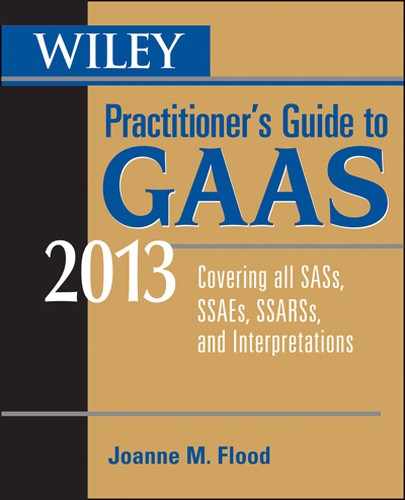AU 550: Other Information in Documents Containing Audited Financial Statements
AU-C 720: Other Information in Documents Containing Audited Financial Statements
AU EFFECTIVE DATE AND APPLICABILITY
| Original Pronouncement | Statement on Auditing Standards (SAS) 118. |
| Effective Date | This statement currently is effective. |
| Applicability | Annual reports or similar documents that are issued to owners or similar stakeholders, and annual reports of governments and organizations for charitable or philanthropic purposes that are available to the public that contain audited financial statements and the auditor’s related report. |
AU-C EFFECTIVE DATE AND SUMMARY OF CHANGES
To address practice issues, SAS No. 118, Other Information in Documents Containing Audited Financial Statements, was one of the clarified standards issued before SAS No. 122. It was issued in February 2010 and is effective for audits of financial statements for periods beginning on or after December 15, 2010.
SAS No. 118 was codified in AU 550 when issued, but was moved to AU-C 720 with the issuance of SAS No. 122. Some conforming changes were made in specific paragraphs and footnotes due to the issuance of SAS No. 122, but no substantive changes were made.
AU DEFINITIONS OF TERMS
Inconsistency. Information that conflicts with the information contained within the audited financial statements. Such an inconsistency may raise doubts about audit conclusions based on audit evidence that was previously obtained, and possibly about the basis for the auditor’s opinion on the financial statements.
Other information. Both financial and nonfinancial information (not including the financial statements and related auditor’s report) that is included in a document that contains audited financial statements and the auditor’s related report. It does not include required supplementary information. Examples of other information are financial summaries, employment data, planned capital expenditures, financial ratios, the names of officers and directors, and selected quarterly data.
Misstatement of fact. Other information unrelated to matters appearing in the audited financial statements that is incorrectly stated or presented. If this misstatement is material, it can undermine the credibility of a document that also contains audited financial statements.
AU-C DEFINITIONS OF TERMS
Source: AU-C 720.05
Inconsistency. Other information that conflicts with information contained in the audited financial statements. A material inconsistency may raise doubt about the audit conclusions drawn from audit evidence previously obtained and, possibly, about the basis for the auditor’s opinion on the financial statements.
Misstatement of fact. Other information that is unrelated to matters appearing in the audited financial statements that is incorrectly stated or presented. A material misstatement of fact may undermine the credibility of the document containing audited financial statements.
Other information. Financial and nonfinancial information (other than the financial statements and the auditor’s report thereon) that is included in a document containing audited financial statements and the auditor’s report thereon, excluding required supplementary information.
OBJECTIVES OF AU SECTION 550
A document containing audited financial statements and the associated auditor’s report may include other information that could undermine the credibility of the financial statement and auditor’s report. This section describes the steps that an auditor should follow to ascertain the presence of material inconsistencies or material misstatements of facts in this other information, and subsequent steps, required if such issues do exist.
OBJECTIVE OF AU-C SECTION 720
AU-C Section 720.04 states that:
. . . the objective of the auditor is to respond appropriately when the auditor becomes aware that documents containing audited financial statements and the auditor’s report thereon include other information that could undermine the credibility of those financial statements and the auditor’s report.
FUNDAMENTAL REQUIREMENTS
The auditor should take the following steps:
| Situation | Auditor Action |
| There is a material inconsistency that requires revision of the financial statements, and management refuses to make the revision. | Modify the auditor’s opinion in accordance with Section 508, Reports on Audited Financial Statements. |
| There is a material inconsistency that requires revision of the other information and management refuses to make the revision. | Communicate the issue to those charged with governance. Also, either include in the auditor’s report an explanation of the material inconsistency, or withhold the auditor’s report, or withdraw from the engagement. |
| Situation | Auditor Action |
| There is a material inconsistency that requires revision of the financial statements | Apply Section 561, Subsequent Discovery of Facts Existing at the Date of the Auditor’s Report |
| There is a material inconsistency that requires revision of the other information and management agrees to make the revision. | Complete those procedures necessary under the circumstances. |
| There is a material inconsistency that requires revision of the other information management refuses to make the revision. | Notify those charged with governance, and take further actions as appropriate. |
INTERPRETATIONS
There are no interpretations for this section.
ILLUSTRATION
It is not necessary to reference the other information in the auditor’s report on the financial statements. However, if the auditor believes that he or she could be associated with the information, this may imply a level of assurance that the auditor did not intend. Accordingly, consider using the disclaimer in Illustration 1 to disclaim an opinion on the other information.
